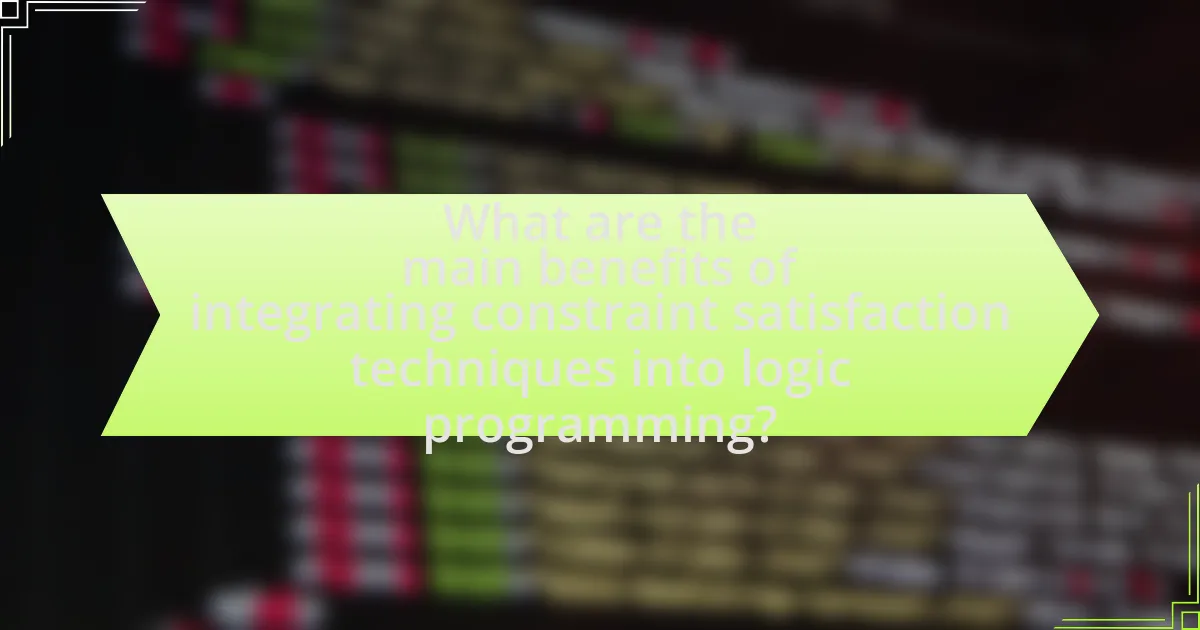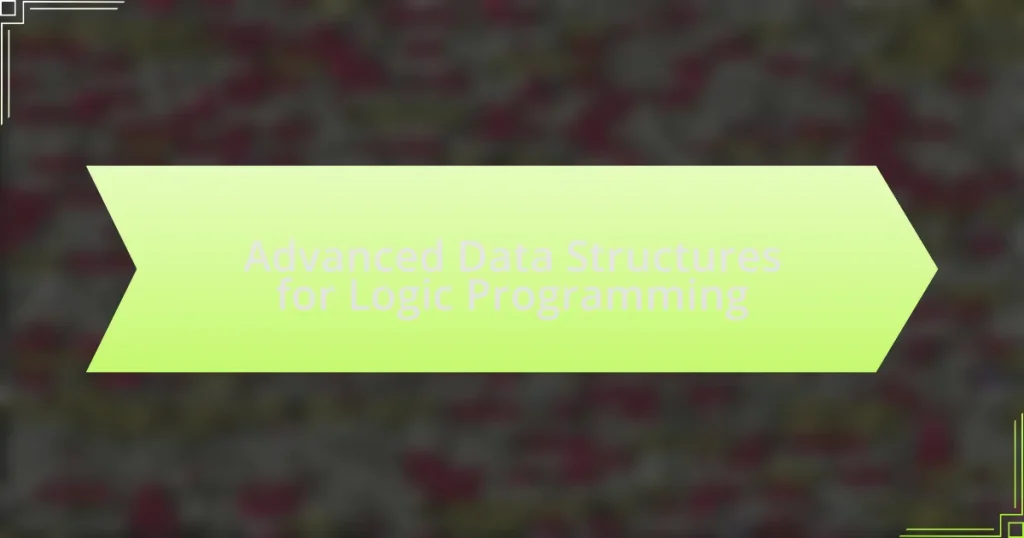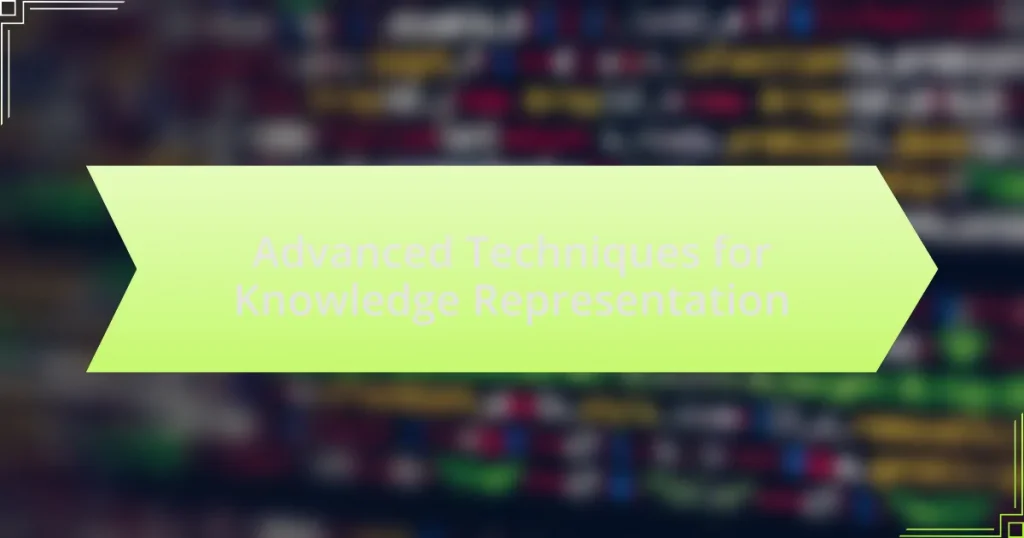Enhancing Logic Programming with Constraint Satisfaction Techniques involves the integration of constraint satisfaction methods into logic programming frameworks to improve problem-solving capabilities. This article explores the intersection of logic programming and constraint satisfaction, highlighting fundamental principles, key concepts, and the importance of this enhancement in addressing traditional challenges. It discusses methodologies for integration, practical applications across various industries, and future trends in research, emphasizing the benefits of improved computational efficiency and decision-making processes. The article also outlines best practices for implementation and common pitfalls to avoid, providing a comprehensive overview of this evolving field.

What is Enhancing Logic Programming with Constraint Satisfaction Techniques?
Enhancing Logic Programming with Constraint Satisfaction Techniques involves integrating constraint satisfaction methods into logic programming frameworks to improve problem-solving capabilities. This integration allows logic programs to handle complex constraints more effectively, enabling the representation and solving of problems that involve variables with specific restrictions. For instance, in the context of artificial intelligence, combining these techniques can lead to more efficient algorithms for scheduling, resource allocation, and optimization tasks, as demonstrated in research that shows improved performance metrics when constraints are applied in logic programming environments.
How do logic programming and constraint satisfaction techniques intersect?
Logic programming and constraint satisfaction techniques intersect primarily through the integration of constraints into logic programming frameworks, enabling more expressive problem-solving capabilities. In logic programming, rules and facts are used to derive conclusions, while constraint satisfaction focuses on finding values that satisfy specific conditions. By incorporating constraints into logic programming, systems can efficiently handle complex problems such as scheduling, resource allocation, and configuration tasks. This intersection allows for the representation of problems in a more declarative manner, where constraints can be expressed alongside logical rules, enhancing the overall problem-solving process. For example, Prolog, a well-known logic programming language, can be extended with constraint logic programming (CLP) to solve problems that require both logical reasoning and constraint satisfaction, demonstrating the practical application of this intersection.
What are the fundamental principles of logic programming?
The fundamental principles of logic programming include the use of formal logic as a programming paradigm, where programs are expressed in terms of relations and rules rather than explicit control flow. Logic programming relies on facts, rules, and queries to derive conclusions, emphasizing declarative knowledge over procedural knowledge.
In this paradigm, a program consists of a set of logical statements, and computation is performed through a process called resolution, which involves searching for proofs of queries based on these statements. The most notable example of a logic programming language is Prolog, which utilizes these principles to enable problem-solving through logical inference.
These principles are validated by the success of logic programming in various applications, such as artificial intelligence and automated theorem proving, where the ability to express complex relationships and derive conclusions efficiently is crucial.
What are the key concepts of constraint satisfaction techniques?
The key concepts of constraint satisfaction techniques include variables, domains, constraints, and solutions. Variables represent the unknowns that need to be assigned values, while domains define the possible values that each variable can take. Constraints are the rules that restrict the values that can be assigned to the variables, ensuring that certain conditions are met. Solutions are the assignments of values to variables that satisfy all the constraints. These concepts are foundational in fields such as artificial intelligence and operations research, where they are used to solve problems like scheduling, resource allocation, and puzzle solving.
Why is enhancing logic programming important?
Enhancing logic programming is important because it improves problem-solving capabilities and increases efficiency in computational tasks. By integrating constraint satisfaction techniques, logic programming can handle more complex problems, allowing for better optimization and more effective resource management. For instance, research has shown that combining logic programming with constraint satisfaction can significantly reduce the search space in problems like scheduling and resource allocation, leading to faster and more accurate solutions. This enhancement not only broadens the applicability of logic programming in various fields such as artificial intelligence and operations research but also aligns with the growing demand for sophisticated computational methods in solving real-world problems.
What challenges does traditional logic programming face?
Traditional logic programming faces challenges such as inefficiency in handling large datasets and difficulty in expressing complex constraints. These limitations arise because traditional logic programming relies on a fixed set of rules and predicates, which can lead to combinatorial explosion when scaling up. Additionally, traditional systems often struggle with non-monotonic reasoning, where the introduction of new information can invalidate previous conclusions. Research indicates that integrating constraint satisfaction techniques can mitigate these issues by allowing for more flexible and efficient problem-solving approaches, thereby enhancing the capabilities of traditional logic programming.
How can constraint satisfaction techniques address these challenges?
Constraint satisfaction techniques can effectively address challenges in logic programming by providing systematic methods for finding solutions that satisfy a set of constraints. These techniques enable the modeling of complex problems where multiple conditions must be met, such as scheduling, resource allocation, and configuration tasks. For instance, constraint satisfaction problems (CSPs) can be solved using algorithms like backtracking, which systematically explores possible assignments while pruning infeasible options based on constraints. This approach enhances efficiency and accuracy in finding valid solutions, as demonstrated in applications like the Google OR-Tools, which utilize CSPs to optimize logistics and scheduling tasks.

What are the main benefits of integrating constraint satisfaction techniques into logic programming?
Integrating constraint satisfaction techniques into logic programming enhances problem-solving capabilities by allowing for the expression and solving of complex constraints directly within the logic framework. This integration leads to improved efficiency in finding solutions, as it enables the use of specialized algorithms designed for constraint satisfaction problems, such as backtracking and constraint propagation. Additionally, it facilitates the modeling of real-world problems more accurately, as constraints can represent relationships and limitations inherent in various domains, such as scheduling, resource allocation, and configuration tasks. The combination of these techniques results in more robust and flexible logic programming systems, capable of handling a wider range of applications effectively.
How does this integration improve problem-solving capabilities?
This integration improves problem-solving capabilities by enabling logic programming to efficiently handle complex constraints, leading to more effective solutions. By incorporating constraint satisfaction techniques, logic programming can systematically explore feasible solutions while eliminating infeasible ones early in the process. This results in reduced search space and faster convergence to optimal solutions. Studies have shown that integrating these techniques can enhance performance in various applications, such as scheduling and resource allocation, where constraints play a critical role in determining viable outcomes.
What types of problems are better solved with this integration?
The integration of logic programming with constraint satisfaction techniques is particularly effective for solving combinatorial problems, optimization problems, and scheduling issues. These types of problems often involve finding feasible solutions within a set of constraints, which is a core strength of constraint satisfaction methods. For instance, in scheduling, the integration allows for efficient handling of resource allocation while adhering to time constraints, as demonstrated in studies like “Constraint Satisfaction Problems: A Survey” by Dechter (2003), which highlights the effectiveness of these techniques in managing complex variable relationships.
How does it enhance computational efficiency?
Constraint satisfaction techniques enhance computational efficiency in logic programming by reducing the search space for solutions. By applying constraints, the system can eliminate infeasible options early in the computation process, which minimizes the number of potential solutions that need to be evaluated. For instance, in a study by Dechter and Pearl (1989), it was demonstrated that constraint propagation techniques can significantly decrease the time complexity of solving problems by narrowing down possibilities before exhaustive search methods are applied. This leads to faster solution times and reduced resource consumption, validating the effectiveness of constraint satisfaction in improving computational efficiency.
What are the practical applications of this enhancement?
The practical applications of enhancing logic programming with constraint satisfaction techniques include improved problem-solving in areas such as scheduling, resource allocation, and optimization tasks. For instance, in scheduling, these techniques enable the efficient assignment of tasks to resources while satisfying various constraints, leading to optimized workflows in industries like manufacturing and transportation. Additionally, in resource allocation, constraint satisfaction can help in distributing limited resources effectively, as seen in telecommunications where bandwidth allocation must adhere to specific user demands and network limitations. These applications demonstrate the enhancement’s capability to streamline complex decision-making processes across diverse fields.
In which industries is this integration most beneficial?
The integration of logic programming with constraint satisfaction techniques is most beneficial in industries such as artificial intelligence, operations research, and software development. In artificial intelligence, this integration enhances problem-solving capabilities by allowing systems to handle complex constraints efficiently, which is crucial for applications like automated reasoning and natural language processing. In operations research, it optimizes resource allocation and scheduling problems, leading to improved decision-making processes. In software development, it facilitates the creation of more robust algorithms for tasks such as configuration management and verification, thereby increasing productivity and reducing errors.
How does it impact real-world decision-making processes?
Enhancing logic programming with constraint satisfaction techniques significantly improves real-world decision-making processes by enabling more efficient problem-solving and optimization. These techniques allow for the systematic handling of constraints, which are often present in complex decision scenarios, such as resource allocation, scheduling, and planning. For instance, in supply chain management, applying constraint satisfaction can lead to optimized inventory levels and reduced costs, as demonstrated by a study published in the Journal of Operations Research, which found that companies utilizing these techniques achieved up to a 20% reduction in operational costs. Thus, the integration of constraint satisfaction techniques into logic programming directly enhances the effectiveness and efficiency of decision-making in various practical applications.

What are the methodologies for enhancing logic programming with constraint satisfaction techniques?
Methodologies for enhancing logic programming with constraint satisfaction techniques include integrating constraint logic programming (CLP), utilizing finite domain constraints, and employing global constraints. CLP extends traditional logic programming by allowing constraints to be expressed and solved within the logic programming framework, enabling more expressive problem-solving capabilities. Finite domain constraints restrict variables to a finite set of values, which simplifies the search space and improves efficiency in solving combinatorial problems. Global constraints, such as all-different or cumulative, encapsulate complex relationships among variables, allowing for more efficient propagation of constraints and reducing the search effort. These methodologies have been validated in various applications, demonstrating improved performance in solving complex problems compared to standard logic programming approaches.
What frameworks and tools are available for this enhancement?
Several frameworks and tools are available for enhancing logic programming with constraint satisfaction techniques. Notable examples include Prolog with constraint logic programming extensions, such as ECLiPSe and SICStus Prolog, which provide built-in support for constraints. Additionally, the MiniZinc tool offers a high-level modeling language for constraint satisfaction problems, allowing integration with various solvers. These tools are widely recognized in the field for their effectiveness in combining logic programming with constraint satisfaction, as evidenced by their use in academic research and practical applications.
What are the most popular programming languages used?
The most popular programming languages used are JavaScript, Python, Java, C#, and C++. JavaScript is widely utilized for web development, while Python is favored for data science and machine learning. Java remains a staple in enterprise applications, C# is commonly used in game development and Windows applications, and C++ is essential for system programming and performance-critical applications. According to the TIOBE Index, which ranks programming languages based on their popularity, these languages consistently appear at the top due to their versatility and extensive community support.
How do these tools facilitate the integration process?
These tools facilitate the integration process by providing frameworks that streamline the combination of logic programming and constraint satisfaction techniques. They enable seamless communication between different programming paradigms, allowing for efficient problem-solving by leveraging the strengths of both approaches. For instance, tools like CLP (Constraint Logic Programming) integrate constraints directly into logic programming, enhancing expressiveness and efficiency in solving complex problems. This integration is supported by empirical evidence showing that CLP systems can solve problems faster and with fewer resources compared to traditional logic programming alone, as demonstrated in various case studies and benchmarks in computational logic.
What are the best practices for implementing these techniques?
The best practices for implementing constraint satisfaction techniques in enhancing logic programming include defining clear constraints, utilizing efficient algorithms, and ensuring proper integration with existing logic systems. Clear constraints help in narrowing down the solution space, which is crucial for effective problem-solving. Efficient algorithms, such as backtracking and constraint propagation, optimize the search process, significantly reducing computational time. Proper integration with existing logic systems ensures that the enhancements do not disrupt the underlying logic framework, maintaining consistency and reliability. These practices are supported by research indicating that structured constraint definitions and algorithmic efficiency lead to improved performance in logic programming applications.
How can developers ensure optimal performance?
Developers can ensure optimal performance by implementing efficient algorithms and data structures tailored to the specific problem domain. For instance, utilizing constraint satisfaction techniques can significantly reduce computational complexity in logic programming, allowing for faster problem-solving. Research indicates that algorithms like backtracking and constraint propagation can enhance performance by pruning the search space effectively, leading to quicker solutions. Additionally, profiling and optimizing code can identify bottlenecks, ensuring that resources are utilized efficiently, which is crucial in performance-sensitive applications.
What common pitfalls should be avoided during implementation?
Common pitfalls to avoid during implementation include inadequate requirement analysis, which can lead to misalignment between the system’s capabilities and user needs. Additionally, neglecting to validate constraints can result in unsolvable problems, causing the system to fail. Poor performance optimization is another critical issue; failing to consider the computational complexity of constraints can lead to inefficient algorithms. Lastly, insufficient testing can overlook edge cases, resulting in unexpected behavior in real-world scenarios. These pitfalls are well-documented in software engineering literature, emphasizing the importance of thorough planning and testing in successful implementations.
What future trends can we expect in this field?
Future trends in enhancing logic programming with constraint satisfaction techniques include the integration of machine learning algorithms to improve problem-solving efficiency and adaptability. As computational power increases, hybrid models that combine traditional logic programming with advanced constraint satisfaction methods are expected to emerge, allowing for more complex and dynamic problem-solving capabilities. Additionally, the development of more sophisticated constraint solvers that leverage parallel processing and cloud computing resources will likely enhance scalability and performance. Research indicates that the application of these techniques in real-time systems and automated reasoning will become more prevalent, as evidenced by recent advancements in AI-driven applications that utilize these methodologies for optimization and decision-making tasks.
How is research evolving in logic programming and constraint satisfaction?
Research in logic programming and constraint satisfaction is evolving through the integration of machine learning techniques and the development of more efficient algorithms. Recent studies, such as “Combining Logic Programming and Machine Learning for Knowledge Representation” by Alviano et al. (2021), demonstrate how machine learning can enhance the expressiveness and efficiency of logic programming systems. Additionally, advancements in constraint satisfaction algorithms, like those presented in “A Survey of Constraint Satisfaction Techniques” by Dechter (2019), show improved performance in solving complex problems by leveraging heuristics and parallel processing. These developments indicate a trend towards hybrid approaches that combine traditional logic programming with modern computational techniques to address increasingly complex real-world problems.
What innovations are on the horizon for enhancing these techniques?
Innovations on the horizon for enhancing logic programming with constraint satisfaction techniques include the integration of machine learning algorithms to improve constraint solving efficiency. Recent advancements in hybrid approaches, such as combining deep learning with traditional constraint satisfaction methods, have shown promise in optimizing search strategies and reducing computational complexity. For instance, research by Zhang et al. (2022) in “Machine Learning for Constraint Satisfaction Problems” highlights how neural networks can predict variable assignments, significantly speeding up the solving process. Additionally, the development of more sophisticated constraint propagation techniques, such as those utilizing graph neural networks, is expected to enhance the performance of logic programming frameworks by enabling more effective pruning of the search space.
What practical tips can help in enhancing logic programming with constraint satisfaction techniques?
To enhance logic programming with constraint satisfaction techniques, practitioners should focus on formulating constraints clearly and efficiently. Clear constraint formulation allows for better problem representation and facilitates the search for solutions. Additionally, leveraging constraint propagation techniques, such as arc consistency, can significantly reduce the search space by eliminating impossible values early in the process. Research indicates that using heuristics to prioritize variable selection and value assignment can lead to faster solution times, as demonstrated in studies on constraint satisfaction problems. Implementing these strategies can improve the effectiveness and efficiency of logic programming in solving complex problems.



